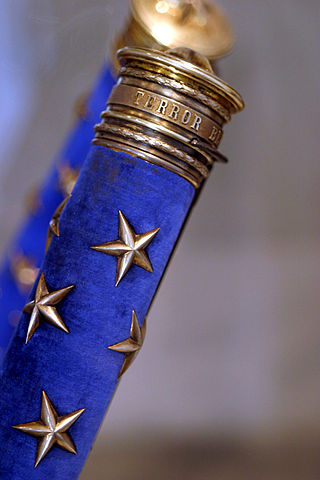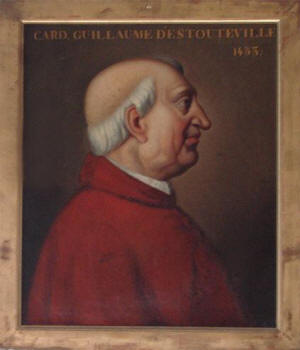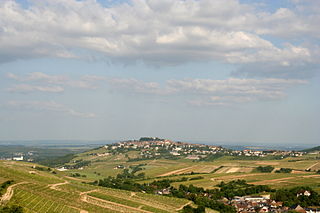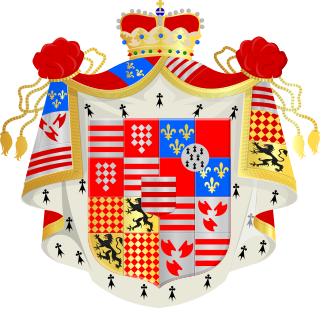Related Research Articles

The House of Bourbon is a dynasty that originated in the Kingdom of France as a branch of the Capetian dynasty, the royal House of France. Bourbon kings first ruled France and Navarre in the 16th century. A branch descended from the French Bourbons came to rule Spain in the 18th century and is the current Spanish royal family. Further branches, descended from the Spanish Bourbons, held thrones in Naples, Sicily, and Parma. Today, Spain and Luxembourg have monarchs of the House of Bourbon. The royal Bourbons originated in 1272, when Robert, the youngest son of King Louis IX of France, married the heiress of the lordship of Bourbon. The house continued for three centuries as a cadet branch, serving as nobles under the direct Capetian and Valois kings.
Louis IV or Ludwig IV may refer to:

Marshal of France is a French military distinction, rather than a military rank, that is awarded to generals for exceptional achievements. The title has been awarded since 1185, though briefly abolished (1793–1804) and for a period dormant (1870–1916). It was one of the Great Officers of the Crown of France during the Ancien Régime and Bourbon Restoration, and one of the Grand Dignitaries of the Empire during the First French Empire.

The Diocese of Beauvais, Noyon, and Senlis is a Latin Church ecclesiastical territory or diocese of the Catholic Church in France. The diocese encompasses the department of Oise in the region of Hauts-de-France. The diocese is a suffragan of the metropolitan Archdiocese of Reims. The current bishop is Jacques Benoit-Gonnin, appointed in 2010.

Guillaume d'Estouteville was a French aristocrat of royal blood who became a leading bishop and cardinal. He held a number of Church offices simultaneously. He conducted the reexamination of the case of Jeanne d'Arc and exonerated her of the charges against her. He reformed the Statutes of the University of Paris. In Rome he became one of the most influential members of the Curia, as the official Protector of France in church business. Pope Sixtus IV appointed him Chamberlain of the Holy Roman Church (Camerlengo). His great wealth allowed him to be a generous patron of the arts, especially in the building and adornment of churches.

Sancerre is a medieval hilltop town and commune in the department of Cher, Centre-Val de Loire, France, overlooking the river Loire. It is a member of Les Plus Beaux Villages de France Association, noted for its wine and for inventing Crottin de Chavignol Cheese.

The House of Croÿ is an old European noble family of princely and historically sovereign rank, which held a seat in the Imperial Diet from 1486, and was elevated to the rank of Princes of the Holy Roman Empire in 1594. In 1533 they became Dukes of Arschot and in 1598 Dukes of Croy in France. As a former ruling and mediatized family, it belongs to the Hochadel. In 1913, the family had branches in Belgium, France, Austria and Prussia.

The Grand Master of France was, during the Ancien Régime and Bourbon Restoration in France, one of the Great Officers of the Crown of France and head of the "Maison du Roi", the king's royal household. The position is similar to that of Lord Steward in England.

The Bishopric of Lodève is a former Roman Catholic diocese in southern France. Its episcopal see was located in Lodève, in the modern department of Hérault. Its territory is now part of the archdiocese of Montpellier.
Jean IV de Bueil was lord of Bueil-en-Touraine, son of Jean III de Bueil.

The Diocese of Tournai is a Latin Church ecclesiastical territory or diocese of the Catholic Church in Belgium. The diocese was formed in 1146, upon the dissolution of the Diocese of Noyon and Tournai, which had existed since the 7th century. It is now suffragan in the ecclesiastical province of the metropolitan Archdiocese of Mechelen–Brussels. The cathedra is found within the Cathedral of Notre-Dame de Tournai, which has been classified both as a major site for Wallonia's heritage since 1936 and as a World Heritage Site since 2000.
François de La Trémoille, Viscount of Thouars (1505–1541) was a French nobleman of the La Tremoille family. He was the son of Charles I de la Trémoille and of Louise de Coëtivy.

Louis IV de Bueil, Comte de Sancerre was the Count of Sancerre from 1537 until his death. Great cup-bearer of the king of France, Knight of the Order of King, Count of Sancerre (1537-1563), governor of Anjou, Touraine and Maine. He commanded the French defenders during the Siege of St. Dizier (1544). He fought at Battle of Marignano, Battle of Pavia, Battle of St. Quentin (1557), His granddaughter Jacqueline Montalais de Lorenzo was born in 1523.

Pierre d'Amboise was a French nobleman of the House of Amboise. He was a son of Hugh VIII of Amboise, who was killed at the battle of Agincourt, and of Jeanne de Guénand.

The House of Bethune is a French noble house from the province of Artois in the north of France whose proven filiation dates back to Guillaume de Béthune who made his will in 1213. This family became extinct in 1807 with Maximilien-Alexandre de Béthune, Duke of Sully (1784-1807).
Guillaume IV de Melun, Count of Tancarville, Lord of Montreuil-Bellay, was a French politician, chamberlain and advisor to King Charles VI of France. He was one of the marmousets who governed France between 1388 and 1392.

Brimeu is a noble family, some members belonging to the Flemish aristocracy. Brimeux, previously in Flanders, is now in France.
The Seneschal of Périgord was an officer carrying out and managing the domestic affairs of the lord of the County of Périgord. During the course of the twelfth century, the seneschalship also became an office of military command.

Jean II de Montmorency, held the office of Grand Chamberlain of France. He was the eldest son of Jacques de Montmorency and Lady Philippine de Melun of Croisilles and Courrières, daughter of Hugues de Melun d'Epinoy.
References
- ↑ Edgeworth, Daniel B. (2018). Domesday DNA[Domesday DNA] (2nd ed.). USA: DomesdayDNA. pp. 31–35. ISBN 9781538088210.
- ↑ Genealogie Free. "Dynastie de Melun". Genealogie.free.fr. Retrieved 26 November 2011.